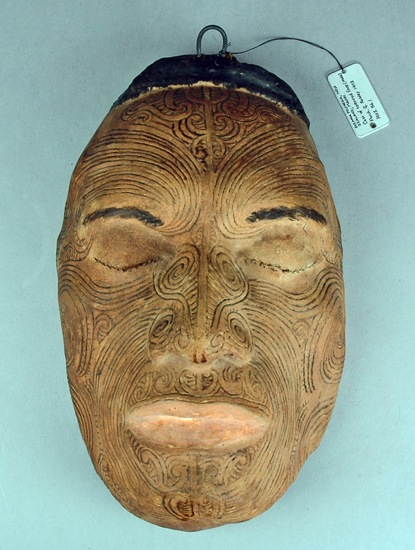Plaster cast of a Māori chief
 Purchased from General Robley in 1903; 1903.56.1Māori people, New Zealand, c. 1854
Purchased from General Robley in 1903; 1903.56.1Māori people, New Zealand, c. 1854
This painted mask is a likeness of Māori chief Tapua Te Whanoa of the Ngati Whakaue hapu of the Rotorua region. The plaster has been etched with a full facial moko presumably in imitation of the chief's actual tattoos. The lines have been coloured black (possibly with liquid charcoal) and then sealed with varnish. An identical mask is held at the Museum of New Zealand Te Papa Tongawera at Wellington, made in 1854 for Sir George Grey, Governor of New Zealand. The Wellington mask is probably the original cast (done from life) from which this replica was later made.
This cast may have been done from life but it was an old Māori custom to preserve the heads of the nobility (mokomokai), possibly as a way of retaining that person's tapu or magical and sacred qualities. The Europeans who arrived in Aotearoa (New Zealand) from the late 18th century developed a taste for these 'curios' and a established an appreciable – and at times unscrupulous – trade in preserved heads, often in return for firearms and ammunition. The trade in mokomokai was eventually banned by the authorities in 1831, but it had already proved a disincentive for many Māori men to continue to wear moko. Combined with cultural changes administered through colonialism and missionization, this meant that by the mid-19th century tā moko was in decline and by the end of the century, had practically disappeared.
Among the first Westerners to encounter the Māori was Sir Joseph Banks, the naturalist on Cook's first voyage. Contrary to some reports, there is no evidence to suggest that Banks ever collected mokomokai. Indeed, his admiration for the art of moko was clear in his journal entry of 1770:
"Their faces are the most remarkable, on them they by some art unknown to me dig furrows in their faces a line deep at least and as broad, the edges of which are often again indented and most perfectly black...It is impossible to avoid admiring the immense Elegance and Justness of the figures in which it is form'd, which in the face is always different spirals...finished with with a masterly taste and execution."
'Account of New Zealand', The Endeavour Journal of Sir Joseph Banks, 1768–1771
Today, there has not only been a rediscovery of tā moko as an art form but there are also ongoing campaigns to repatriate to New Zealand the many mokomokai that reside in museums and private collections around the world.
